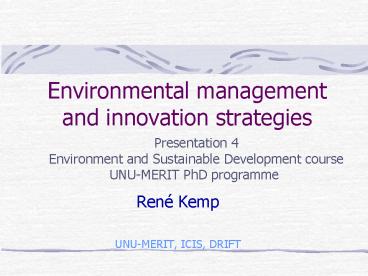Environmental management and innovation strategies - PowerPoint PPT Presentation
1 / 21
Title:
Environmental management and innovation strategies
Description:
It is wrong to see environmental technologies as those that deal with pollution. ... air pollution) to the higher cost of investments in environmental technologies ... – PowerPoint PPT presentation
Number of Views:94
Avg rating:3.0/5.0
Title: Environmental management and innovation strategies
1
Environmental management and innovation strategies
Presentation 4 Environment and Sustainable
Development course UNU-MERIT PhD programme
- René Kemp
- UNU-MERIT, ICIS, DRIFT
2
- It is wrong to see environmental technologies as
those that deal with pollution. We need to have a
broader mindset - Our perspective on what technologies are green,
brown, or environmentally-friendly has been
conditioned by decades of regulatory obsession.
Like all obsessions, this is psychologically
comforting but cognitively limited, and has
focussed our collective attention on
hardware-based solutions to waste minimizations
and end-of-pipe solutions. (Rejeski)
3
- Eco-innovations may be developed with or without
the explicit aim of reducing environmental harm - They may be a side effect of the usual business
goals such as productivity or enhancing product
quality
4
(No Transcript)
5
Source IMPRESS survey under 1594 companies in
five European countries (Germany, Italy,
Switzerland, the United Kingdom, the
Netherlands).
6
(No Transcript)
7
Barriers to eco-innovation
- economic barriers, ranging from market prices
which do not reflect the external costs of
products or services (such as health care costs
due to urban air pollution) to the higher cost of
investments in environmental technologies because
of their perceived risk, the size of the initial
investment or the complexity of switching from
traditional to environmental technologies - regulations and standards can also act as
barriers to innovation when they are unclear or
too detailed, while good legislation can
stimulate environmental technologies - insufficient research efforts, coupled with
inappropriate functioning of the research system
in European countries and weaknesses in
information and training - inadequate availability of risk capital to move
from the drawing board to the production line - lack of market demand from the public sector, as
well as from private companies and consumers
- Source ETAP
8
Source Ashcroft
9
Source Ashcroft
10
Source Adeoti (2001)
11
Source Adeoti (2001)
12
Source Adeoti (2001)
13
Source Adeoti (2001)
14
Source Adeoti (2001)
15
Source Luken and van Rompay (2006)
16
Source Luken and van Rompay (2006)
17
Source Luken and van Rompay (2006)
18
Different frameworks and methods
- Rathi no espoused framework
- Ekboir innovation system framework in which a
technology and the network of actors is central
unit of analysis (with special attention to role
of public research) - Clark, Hall.. capacity framework with attention
to actors, institutions, beliefs, knowledge and
capabilities - Luken and van Rompay Multiple stimuli framework
(regulator, market, community) using surveys and
interviews - Adeoti Major drivers and auxiliary drivers
framework using survey and interviews plus
institutional analysis
19
(No Transcript)
20
(No Transcript)
21
Conclusions of Environment council--
continued 5. The pro-activity of business should
be strengthened by for example rewarding
front-runners and bench marking of eco-efficiency
performance. 6. Clear and ambitious long-term
targets can drive innovations. Environmental
legislation should be founded on fact-based and
balanced impact-assessments, consistent, flexible
and future oriented and not technology
prescriptive. The EU could make EU legislation
more supportive of eco-efficient innovations by
engaging in an active dialogue on these
aspects. 7. Focussed long-term research and
development efforts are crucial to further
develop new innovations. 8. A joint effort with
business is needed to fully grasp the
opportunities of eco-efficient innovations. A
well informed and proactive dialogue with
industry and other stakeholders should be
continued. Strong support for SMEs through risk
capital provision and capacity building is
important to capitalize on their important role
in the innovation process. National and local
support is needed for this. 9. The Environment
Council should create alliances with other
Councils to create supportive conditions for
eco-efficient innovations given the economic and
ecological benefits.































